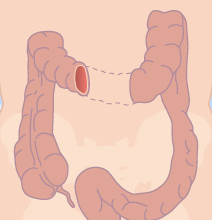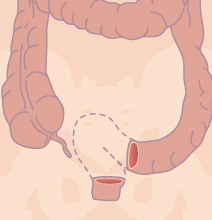Less invasive surgeries
Laparoscopic-assisted colectomy
Laparoscopic-assisted colectomy is starting to be more and more used. Its minimal invasive character reduces damage to the organs and tissues around the tumor.
In fact, instead of a large incision on the abdomen, laparoscopy uses a several tiny “holes” to perform the surgery on the colon.
To start, the surgeon does four to five small cuts on the abdomen to insert the necessary surgical instruments. One of them (the laparoscope) contains a small video camera on its end, which feeds images to an outside monitor to guide the doctor through the operation.
Once the colon is cut on both sides, it is removed through one of the incisions on the abdomen.
As in traditional colectomy, when the tumor is removed, also the surrounding tissues, as well as the nearest lymph nodes.
Because the incisions are smaller than in a traditional colectomy, laparoscopic-assisted colectomy carries several advantages: faster and less painful recovery, a better cosmetic result, as well as recovery of the functions of the intestine.
This is a promising technique, as research has shown that patient outcome (regarding overall cancer survival and disease recurrence) is similar whether colon surgery is done in a traditional way or by laparoscopy.





